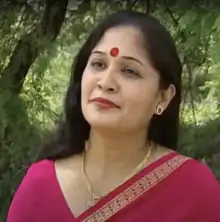Swathi Somnath | |
|---|---|
 Swathi in October 2020 | |
| Born | Doosi Swathi |
| Education | |
| Occupation | Kuchipudi dancer |
| Known for | Ballet based on Kama Sutra |
| Awards | Kala Ratna |
Swathi Somnath (born Doosi Swathi)[1] is an Indian Kuchipudi exponent and dance teacher from the state of Andhra Pradesh. She performed a dance ballet based on Kama Sutra, Hindu literature on erotic love, through which she gained recognition. She received Kala Ratna award in 2006. She established Nritya Bharathi in Hyderabad and Sampradayam Dance and Music Centre in Srikakulam district.
Personal life
Swathi was born to Somnath, an Indian Railways employee, and Lakshmi in Chakradharpur, Bihar (now in Jharkhand) in a Hindu Brahmin[2] family.[lower-alpha 1][4][5] Her family hails from Doosi Agraharam, Srikakulam district.[4] She has one brother who also works in Indian Railways. She grew up in West Bengal before moving to Hyderabad.[2] She completed her education with a Master's degree in Kuchipudi from Central University of Hyderabad,[6] and Master of Philosophy in English Literature.[4] As of October 2020, she is pursuing Ph.D in English Literature from Osmania University.[5] She married Chevella Ravi Kumar, a film director in Telugu cinema.[2]
Kuchipudi dance
Swathi performed Lambadi dance during her school days.[5] She started learning dance when she was 11 year old[1] and later learned Kuchipudi and Bharatanatyam at Sumathi Kaushal for four years at a young age. After completing secondary school, she debuted in August 1980 on stage in Ravindra Bharathi.[4][5] Following her father's death in 1981,[5] she continued her performances to run her house financially, given her family was in lower middle class,[5] and continued her further education simultaneously.[4] Shortly thereafter, she said, she formed her own orchestra at the age of 16 and started performance on her own. In the memory of her father, she changed her last name to his name, Somnath.[2]
Her ballet Vatsayani Kamasutra, based on Vātsyāyana's erotic love Hindu literature, Kama Sutra, garnered her recognition. It was well received among rasikas (audience of Indian classical music) and was criticized by conservative dancers citing the depiction of sringara (erotic love) on the stage.[7][4] Bnim penned the script.[8]
She established a dance academy Nritya Bharathi in Hyderabad in 1990s.[7][4] In 2015, the Government of Andhra Pradesh allocated 12–16 acres (49,000–65,000 m2)[lower-alpha 2] in Kallepalli village near Srikakulam supporting her to set up a cultural centre to teach classical music and dance. Andhra Pradesh Praja Natyamandali among others protested the government's move stating that she was not brought up in Srikakulam district and suggested alternate native dancers be considered for the land allotment.[3][10][9] She eventually established her gurukula academy, Sampradayam Dance and Music Centre and is serving as its director in addition to teaching Kuchipudi.[11][3] According to her, the construction cost of the academy was ₹5 crore (US$630,000). The foundation stone was laid on 15 August 2015, on Indian Independence Day. The institution is affiliated to Sri Venkateswara University, Tirupati and offers certificate courses to students who completed their secondary schooling.[1]
She performed in over 100 ballets, some of which include Draupadi based on Draupadi, Kama To Moksha based on Kama Sutra, Hindutva, Sahrnam Govindam, Soundarya Darshana based on the life of Ramanuja, Sarvagnya Shankara based on the life of Adi Shankara.[7][4]
In an interview with DD Yadagiri, she said she also learned Odissi classical dance although limited to basics.[5]
Other work
She has worked as a member of Central Board of Film Certification and Central Audition Board for Kuchipudi, dance, New Delhi. In addition, she also serves as the principal of College of Music and Dance, Hyderabad.[7]
Awards
Swathi was conferred with Kala Ratna award in 2006 by the government of united Andhra Pradesh for her contributions to Kuchipudi.[12]
Notes
- ↑ The Hindu reported that Swathi was born and brought up at Doosi Agraharam, Srikakulam district, Andhra Pradesh.[3] However, Bnim stated she was born in Bihar.[4]
- ↑ The Hindu reported the allotment as 16 acres (65,000 m2),[9] Sakshi reported 13 acres (53,000 m2).[10] In an interview, Swathi said it was 12 acres (49,000 m2).[1]
References
- 1 2 3 4 Swapna (25 September 2022). శ్రీకాకుళంలో ఆ 12 ఎకరాలు ఎలా వచ్చాయి?-Classical Dancer Swathi Somanath || A Candid Conversation [How did those 12 acres come in Srikakulam?-Classical Dancer Swathi Somanath || A Candid Conversation] (Videotape) (in Telugu). iDream Telugu Movies. Retrieved 14 December 2022.
- 1 2 3 4 Vemuri, Radhakrishna (5 April 2021). Kuchipudi Dancer Swathi Somnath || Open Heart With RK || Season:1-Episode:17 || 07.02.2010 || #OHRK (Videotape) (in Telugu). ABN Andhra Jyothi.
- 1 2 3 "Cultural centre to come up at Kallepalli". The Hindu. 29 January 2016. ISSN 0971-751X. Retrieved 12 December 2022.
- 1 2 3 4 5 6 7 8 9 Bnim (23 October 2014). ""స్వాతి సోమనాథ్" – శింజారవం" [Swathi Somnath]. acchamgatelugu.com. Retrieved 13 December 2022.
- 1 2 3 4 5 6 7 Vijetha || Swathi Somanath (Videotape) (in Telugu). DD Yadagiri. 28 October 2020. Retrieved 14 December 2022.
- ↑ Vishwanath, Narayana (11 January 2014). "Representing The Art of Perfection". The New Indian Express. Retrieved 12 December 2022.
- 1 2 3 4 Vishwanath, Narayana (25 November 2013). "Saving the sanctity of Kuchipudi". The New Indian Express. Retrieved 13 December 2022.
- ↑ Ramakrishna, Lakshmi (22 March 2019). "Artist- writer Bnim: Canvas that's vast and wide". The Hindu. ISSN 0971-751X. Retrieved 13 December 2022.
- 1 2 "Allocation of land to Kuchipudi dancer opposed". The Hindu. 4 July 2015. ISSN 0971-751X. Retrieved 13 December 2022.
- 1 2 "ఎందుకంత ప్రేమ" [Why so much love]. Sakshi (in Telugu). 27 September 2015. Retrieved 13 December 2022.
- ↑ "దృశ్య కావ్యం.. నృత్య రూపకం" [Visual poetry.. Dance metaphor]. Eenadu (in Telugu). 8 January 2022. Retrieved 13 December 2022.
- ↑ "Hamsa awards are now Kalaratna". The Hindu. 15 August 2006. ISSN 0971-751X. Retrieved 12 December 2022.
External links
 Media related to Swathi Somnath at Wikimedia Commons
Media related to Swathi Somnath at Wikimedia Commons